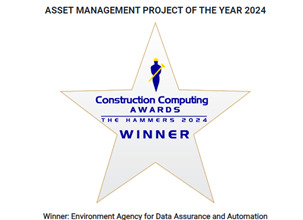Protecting England from Flood Risks
Geospatial Information Management (GeoIM) in Practice: Protecting England from Flood Risks
Matt White, Head of Built Environment at 1Spatial:
Last week’s Geospatial Information Management (GeoIM) for Infrastructure conference hosted by 1Spatial featured some insightful use cases from Government organisations leading the way in this developing area of Information Management for Infrastructure.
With the ongoing storms this week it feels appropriate to highlight the Environment Agency and their award winning work to help protect England from flood risks through effective flood risk management.

The Challenge: Effectively managing £25 billion of flood & coastal defence assets
Investment in the Department for Environment, Food & Rural Affairs (Defra) Flood & Coastal Risk Management Programme (FCRM)[1] stands at £5.2bn over a 6-year period from 2021 to 2027. This investment will deliver 2,000 flood and coastal defence schemes which will protect 336,000 properties, reducing national flood risk by 11% and avoiding £32 billion of wider economic damage caused by flooding and coastal erosion.
The Environment Agency (EA), a non-departmental public body sponsored by Defra, is responsible for operating, maintaining and replacing over seventy thousand existing flood and coastal defence assets which together have a value of £25 billion and reduce the risk of flooding to 1.8m households.
The Approach: A Standards-led approach for Data and Information Assurance
EA has a significant capital program and vast assets. With most of its asset management information commissioned from third parties, it needed to implement point-of-entry information quality assurance into its procurement process to ensure information coming from different systems was consistent and easily understood. EA has adopted a standardised and scalable approach to digital asset information delivery to more effectively manage the information within its Asset Information Management System (AIMS). This hasn’t been an overnight solution as, since 2016, EA was one of the six departments mandated by government to improve productivity in construction by delivering against Building Information Modelling Level 2. EA is now closely aligned with nima the recently rebranded UK BIM alliance, to champion the benefits of trusted, quality data and information. In 2019, EA went a step further and launched a Data Requirements Library to structure its data as a machine-readable format, thereby fit for future needs such as artificial intelligence and machine learning.
EA’s asset data and information assurance were typically performed manually on an ad-hoc basis and was time consuming, with long lead times impacting on planning and budgeting. Due to time-sensitive pressures, sometimes the bare minimum asset information was added simply to get the asset working which creates a legacy data quality problem, hinders digital transformation, reduces both the ability to report on and manipulate information, and to visualise and interrogate it using mapping.
EA have adopted ISO 19650, a standard in how data and information needs to be managed in collaborative frameworks and collaborative contracts. It is focused on defining, checking, and making best use of data, and being able to automate that. So, it’s a specification that tells EA’s suppliers how they need their data and information to be managed, the standards they should be applying, and the skills they should be deploying.
This approach has been recognised as industry leading with an award this year for Asset Management Project of the Year.

As 60% of EA’s flood risk infrastructure data and information has a geospatial / location component, it made sense for EA to partner with geospatial data experts, 1Spatial, to build EA’s data and information assurance service - Datastore, Rules and Visualisation (DRV) - based on 1Spatial’s 1Integrate technology and Safe Software’s FME Flow to provide an automated, robust data and information assurance capability. More information for the details of this capability is provided in the Environment Agency Case study.
The Output: Confidence in Asset Data and Information achieved through Automated Assurance
EA has developed an information management framework that, based upon a rigorously maintained / mandated structured and standardised approach, enables the organisation to deliver data and information that people can trust and can rely upon – from GIS, to analytics, to asset management. Importantly, this also remains the case when data is produced by a 3rd party which is often the position for EA.
[1] Flood and coastal erosion risk management investment plan for 2021 to 2027
Contact us to see how we can help.
Maintaining accurate asset data and information on an ongoing basis is a challenge for any large infrastructure organisations but is critical for effectively operating and maintaining assets against ever challenging budgets. Our GeoIM experts can work with you to understand your immediate needs and 1Spatial’s 1Integrate technology, as a COTS solution, is a scalable solution that can be easily configured to your business rules using generative AI models.
Contact Us
